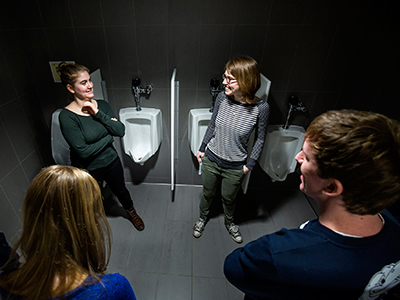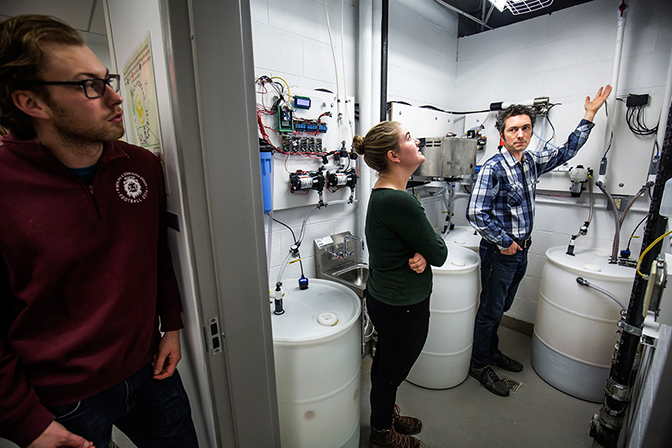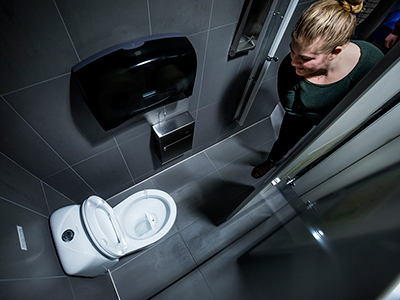New restrooms help demonstrate urine fertilizer concept
The nation’s first end-to-end urine diversion demonstration system opened, a step toward more sustainable and cost-effective fertilizer and wastewater treatment.
The nation’s first end-to-end urine diversion demonstration system opened, a step toward more sustainable and cost-effective fertilizer and wastewater treatment.

Urine could be the sustainable fertilizer of the future.
That’s according to University of Michigan researchers who recently opened two unique restroom facilities that will help them test and refine the idea in the nation’s largest study of its kind.
Turning this waste stream into a commodity is key to more sustainable and cost-effective approaches to both growing crops and treating wastewater, the researchers say. Their $3 million project, funded by the National Science Foundation, explores the technology, systems requirements and social attitudes that go along with urine-derived fertilizers in the U.S.
In addition to researchers from U-M’s Department of Civil and Environmental Engineering, School of Natural Resources and Environment, and School of Public Health, the project involves Vermont-based non-profit the Rich Earth Institute, and the University at Buffalo in New York, as well as other organizations.

In January, the team introduced its end-to-end system. The system collects urine from public facilities – a waterless urinal and a split-bowl toilet – then stores the urine and treats it so the researchers can use it to make various fertilizer products that won’t resemble their source. In the spring, the fertilizers will be applied to selected trees and shrubs at the university’s Nichols Arboretum and Matthaei Botanical Gardens.
“Today we’re celebrating the opening of our urine diversion system,” Nancy Love, a professor of civil and environmental engineering at U-M who leads the project, said at the ribbon cutting. “Our dream is it that one day, it will not be just two fixtures. We hope this practice will expand across campus and beyond.”
The public-facing parts of the system are on the second floor of the G.G. Brown Building in the Department of Civil and Environmental Engineering. The urinal is a typical waterless variety, but it flushes periodically with a spray of vinegar to keep minerals from building up in the pipes. The toilet sends the solid waste (and all toilet paper) that’s collected in the back bowl to the wastewater treatment plant. But it routes the urine that collects in the front bowl elsewhere. These fixtures are, for the most part, off-the-shelf. The innovation is in where the plumbing leads.

The holding tank and treatment lab are one floor below the restrooms. Abe Noe-Hayes, research director at the Rich Earth Institute, devised the set-up.
“This is the first system in the country where all this is combined into one treatment facility, where it can all happen adequately so there’s a minimal amount of maintenance, but it is also full of sampling ports and sensors so the team here can very closely monitor what’s happening,” Noe-Hayes said.
Treatment involves concentrating the urine and distilling it to purify it of any microorganisms, in addition to other steps.
Urine contains nitrogen, phosphorus and potassium – key elements that plants need in order to grow. To get those nutrients to plants today, we manufacture synthetic fertilizers. We get the nitrogen through an energy-intensive process using natural gas. The phosphorus and potassium are mined from nonrenewable ore.
At the same time, these nutrients are polluting rivers and streams in part because we excrete them in urine, and wastewater treatment plants don’t completely remove them before discharging water back into the environment. The Environmental Protection Agency lists nutrient pollution as one of the costliest and most challenging environmental problems the nation faces. Nutrients lead to algae growth that can kill fish and make drinking water undrinkable.

“There are two main reasons we think urine fertilizer is the way of the future,” said Krista Wigginton, assistant professor of civil and environmental engineering and one of the project’s leaders. “Our current agricultural system is not sustainable, and neither is our wastewater treatment approach. The goal here is to divert the nutrient-rich urine right from the beginning and capture those nutrients as a fertilizer.
“It’s being done in other countries around the world. We think it’s time for the US to catch up and start to look at this solution.”
A large part of the project involves social science and public outreach. Rebecca Hardin, an anthropologist at the School of Natural Resources and Environment, leads work examining user attitudes, public opinion, and education efforts. She’ll work with Joe Eisenberg, chair of epidemiology in the School of Public Health, who will lead work on urine-related risk perception and prevention.
As a first step toward gauging public attitudes, tablet computers in the G.G. Brown restrooms outside the stalls ask contributors to take a survey about their experiences using the new technologies, and their broader views on the topic.
Several researchers involved in this project served on the committee that wrote the blueprint for U-M’s new School for Environment and Sustainability, which will open in July.
“In many ways, this project embodies a uniquely U-M approach to collaboration across our campus and also with nonprofit organizations, industries, schools, and communities to solve sustainability challenges,” Hardin said. “That means understanding the links between technological innovation, environmental and health risks, human behaviors and beliefs, and system level changes to improve our lives.”
Other organizations involved include the Hampton Roads Sanitation District in Virginia and New Water Resources in Oregon.